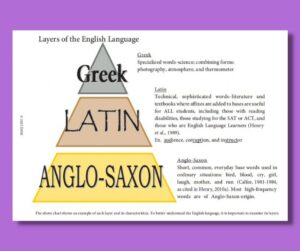Latin
Latin has a tremendous influence on the English language. In fact, “more than 50% of English words contain Latin word roots (King, 2000)” (Henry, 2010, p. 124). Words with Latin bases are mature, technical, sophisticated words found in literature and content-area texts. Examples of words from the Latin layer of our language include the following: audience, commitment, erupt, instructor, portable, and retract.

Recognizing and knowing the meaning of Latin bases increases students’ vocabulary and aids in understanding text. According to Henry (2010), “A study by the National Committee for Latin and Greek found that taking Latin helps increase SAT scores” (p. 52). Learning Latin bases can be beneficial for all students.
Unlike Anglo-Saxon bases, Latin bases are bound morphemes, meaning they can’t stand alone. Latin bases must be affixed (i.e., a prefix and/or suffix must be added to the base to create a word). However, the base provides the most meaning in a word. For example, the Latin base “ject” means “to throw.” The word injection means “to throw in,” while the word reject means “to throw back.”
Remember to make learning Latin bases as multisensory as possible. Consider using pictures or videos to introduce examples of words with Latin bases, and continue to have students create a morpheme card each time a new morpheme is introduced. Provide numerous opportunities for students to see and use the bases in context. See the “Morphology” and “Masters” sections of IMSE’s Morphology Plus Training Manual for more information and ideas for teaching Latin.
